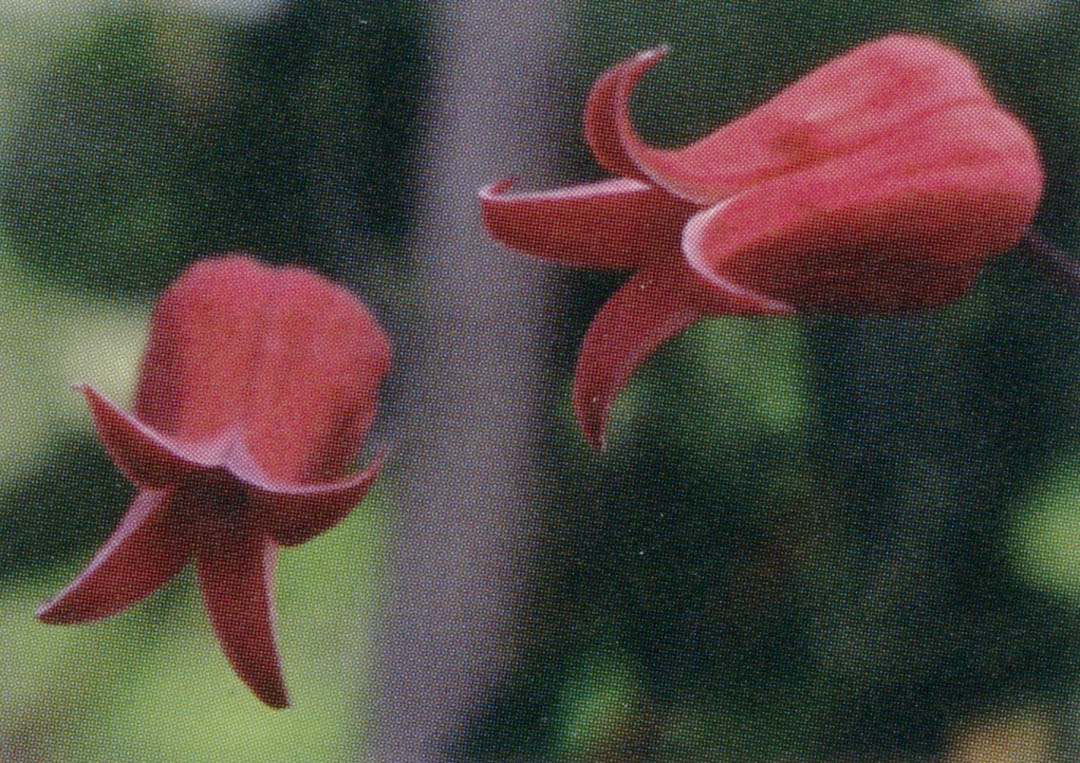

Contributor

… growing and collecting clematis can easily become a happy and healthy obsession.
Mary K Toomey, An Illustrated Encyclopedia of Clematis
The journey began in 1978, as Brewster Rogerson drove a van full of plants from Manhattan, Kansas, to Seattle, Washington. At least, that was the original plan. By unfortunate coincidence, the world convention of Jehovah’s Witnesses was in town, leaving, in Brewster’s words, “no room at the inn.” Heading south, Brewster’s next destination was Portland, where a swarm of summer tourists also left no room at the inn. The next stop was Eugene, Oregon, where, at last, the weary traveler found not only acceptable accommodations for himself but temporary space for his first load of precious cargo: more than sixty vines representing the beginning of his now world-renowned clematis collection.

Brewster was convinced that the maritime climate of the Pacific Northwest would support the broadest number of clematis species and hybrids—certainly more taxa than would tolerate the often harsh winters and brutally hot summers of Kansas. His initial visit was followed by two more trips to transport the rest of the clematis to Oregon, with more adventures to punctuate the journey, including facing down an erupting Mt St Helens with thirty-four vines in a brand new clematis-hauling van. Three total trips were needed to relocate all of the clematis, including the seed flats and cuttings.
Brewster collects things, particularly books, classical music, and plants. That he has narrowed his plant focus to only one genus—clematis—is something of a miracle. As a professor of English at Kansas State University, Brewster first heard the sirens’ song in the form of Clematis ‘Jackmanii’, as have many gardeners. That first introduction began a love affair that continues, unabated, to this day.

International Expansion
Brewster’s passion for knowledge about clematis led him to correspond with major scholars, breeders, and hobbyists in the worldwide gardening community. As his collection grew, the cognoscenti began, in turn, to visit him, and he became a founding member of the International Clematis Society (IClS). Brewster is currently an officer of the society, and his authorship of the Clematis of the Month feature for its website reveals a writer with a profound grasp of his topic and a delicious prose style. He is one of only four Honorary Fellows within the society.
Seeking the closer company of fellow clematis-lovers, Brewster’s journey led him north to the Portland area after five years in Eugene. The collection of containerized plants now fills one eighteen- by ninety-foot greenhouse and the better part of a second at Gutmann Nursery in North Plains, Oregon. Over the last sixteen years, the collection has expanded to 520 taxa represented by 900 plants. The collection also hosts many clematis sent to Brewster by plant collectors for identification and evaluation.
In 2000, Brewster and a handful of other local clematis enthusiasts founded the Pacific Northwest Clematis Society (PNCS). Their first ambition was to invite the International Clematis Society to Portland to honor the thirty-five-year history of Brewster’s collection. The local clematis society’s wish was for the global community to see the collection while Brewster was still able to display it to its best advantage. The international group eagerly accepted the invitation.

In July of 2001, the society’s attendees (representing thirteen nations) were treated to a tour of the treasures within Brewster’s collection, which is unrivaled for comprehensiveness in North America. On display were such plants as the nearly lost, large-flowered ‘Duchess of Waverly’ and ‘Miss Cavell’, the rare single form of Clematis florida, and exceptional examples of North American species, particularly C. texensis. The guests were impressed with the international breadth of the collection, with species and cultivars from Sweden, Japan, Estonia, New Zealand, England, China, Poland, the Crimean region, and several other countries.

Mounting Problems
Soon after the conference, Brewster’s eyesight began to fail. He realized that, even with a cadré of devoted volunteers, he could no longer keep the collection in prime condition. An additional problem has become the location of the collection (all plants in containers within greenhouses) in the country west of downtown Portland, in a private nursery. There is no space available for propagation, hybridizing, or quarantine, when necessary. There is no space for those plants that would much prefer to be in the ground. There is, simply, no garden, and that means no opportunity to show the gardening public the many alternative ways in which these versatile plants can be used.
The volunteers working with him on the collection have become aware, through Brewster’s tutelage, of those species and cultivars that simply find life in a container, within a greenhouse, too alien. One cannot keep potting-on plants into ever larger containers forever, and root pruning can only be attempted so many times on each plant. A few common cultivars, such as the well known large-flowered hybrid ‘Henryii,’ have never prospered in the collection and must be frequently replaced. There has been difficulty getting Chinese seedlings to bloom, and the presumption is that they are reluctant to thrive in pots. A display garden, with trial grounds, would answer many questions, and make most of the collection much happier.
Brewster’s call for help was answered by a group of nurserymen, garden writers, broadcasters, clematis hobbyists, plant society representatives, educators, and staff from the Portland Parks and Recreation Department. They have become his planning committee. Brewster feels the passage of time keenly, and has been told that, within a year, his central vision may be lost forever and, with it, his ability to maintain and extend the collection.
Clearly the time has come for Brewster’s clematis to “go public.” Brewster would like to have his plants grown at a site that is accessible to the public, in order to educate the gardeners of the future. If a suitable site is not found, he will be forced to sell his collection before he loses the ability to care for it.

Are There Solutions?
The final leg of the journey of Brewster’s clematis might take them to an eleven-acre site in southeast Portland. These well-traveled plants, ranging in age from infants to twenty-one years, could get their roots in the ground on a property shared by the Parks Department and the Portland Public School District. The planning committee is helping Brewster to negotiate with the city of Portland and to establish a “Friends of the Collection” foundation.
As the committee’s work progresses, the potential for the clematis to work miracles is becoming apparent. Just the suggestion that the collection be placed at the proposed site has brought the support of the adjoining neighborhood association. Gardening groups, such as the Hardy Plant Society of Oregon (HPSO), are also ready to share the responsibility by creating display gardens. The committee dares to envision that Brewster’s clematis collection may become the engine that powers the development of a long-desired center for urban horticulture within the city of Portland.
What keeps all of these hopes from immediate fruition, naturally, is the need for funding. As mentioned, efforts are now underway to form a foundation, which will fund a full-time curator for the clematis, so that the future director of the collection will not be entirely dependent upon potentially unreliable public moneys.
An indication of the international significance of this collection was the offer by garden writer Mary Toomey, author of The Illustrated Encyclopedia of Clematis (reviewed here in January ’02), to come from Ireland to Portland, at her own expense, to present a day-long clematis workshop in May, as a fundraiser for Brewster’s collection. The Pacific Northwest Clematis Society has authorized its board of directors to make a charitable contribution as soon as the new foundation can legally receive funds. There is now a site plan, and the neighborhood association and Parks Department staff are beginning to move and shake.

Earlier this year, volunteers helped Brewster pot up his spring shipments of new, bare-root clematis as they arrived from Canada, Japan, England, Holland, and elsewhere. Brewster believes, wisely, that any great collection must continue to expand. His unique spirit and foresight have endowed this collection with its vitality and scope.
Will time run out for the collection? Will sufficient funding be found to secure the site and a curator? Could a better location materialize? Will the ‘Duchess of Waverly’ get to send her roots down into real earth? Watch for updates on the fate and further travels of the Rogerson Clematis Collection in future issues of Pacific Horticulture.
[sidebar]
Clematis Resource Guide
To learn more about clematis and about the Rogerson Clematis Collection, consult the website of the International Clematis Society (www.clematisinternational.com) or contact the Pacific Northwest Clematis Society at 13781 Knaus Road, Lake Oswego, OR 97034 (candello@hevanet.com).
[/sidebar]
Share:
Social Media
Garden Futurist Podcast
Most Popular
Videos
Topics
Related Posts

Low Maintenance Gardens – Better for Pollinators and People
Autumn 2022 “I come out every day. It’s therapy, my meditation.” Janet’s young garden transformed from overgrown, invasive plants to mostly natives. The dailiness of

Calochortophilia: A Californian’s Love Affair with a Genus
Summer 2022 I can chart the progression of my life by Calochortus. For the last two decades, at least. As a teenage girl growing up

Pacific Plant People: Carol Bornstein
Spring 2022 Public gardens play a key role in demonstrating naturalistic planting design, selecting native and adapted plants for habitat, and testing techniques for reducing

Add Year-Round Interest and Winter Blooms for Pollinators
Spring 2022 This article was created from an Interview by Merrill Jensen with Neil Bell in the Summer of 2021 for our Pacific Plant People









Responses